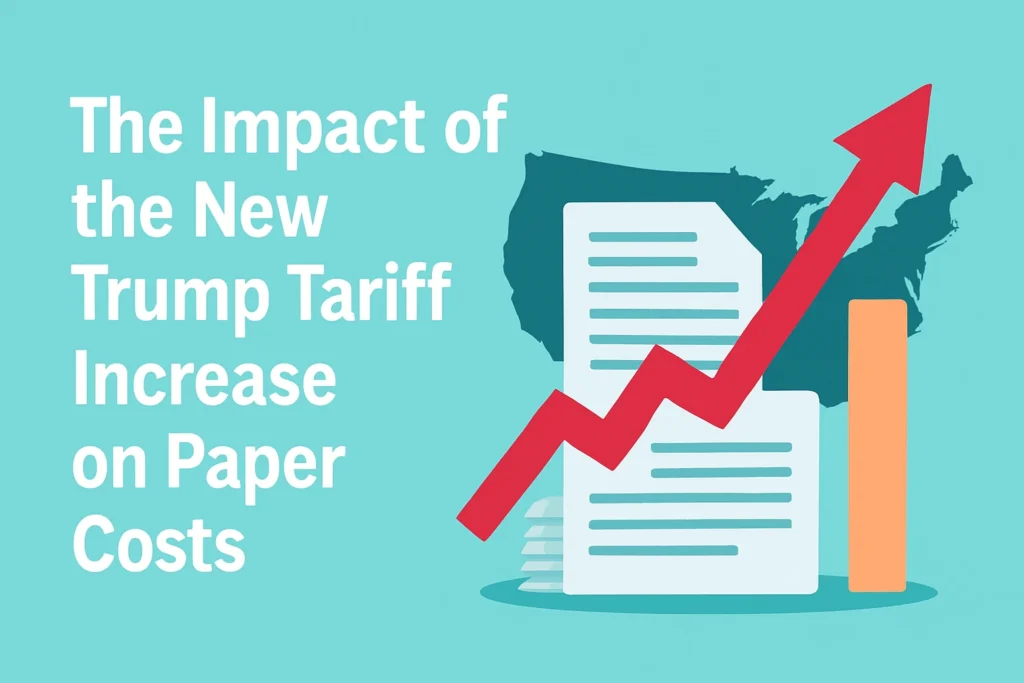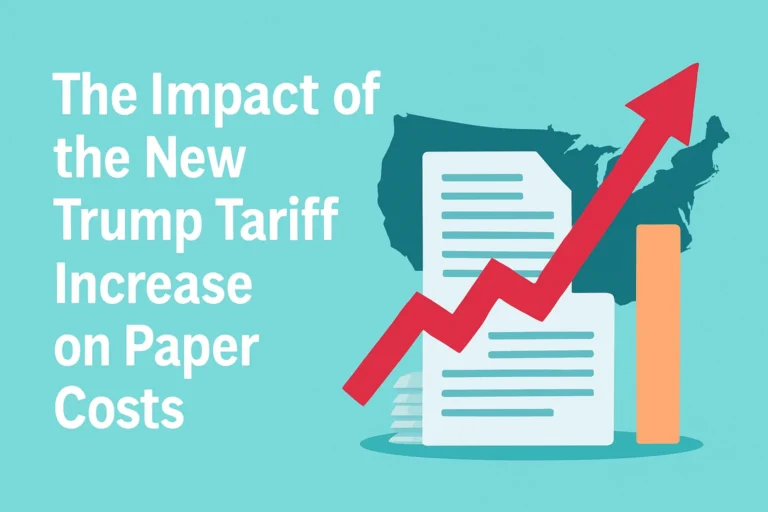
The Trump tariff increase has changed the U.S. paper industry a lot. It has made things hard for newspapers and printing companies all over the country. These new trade rules have caused big economic problems, especially in making newsprint and paper.
Newspapers are really struggling because of the Trump tariff increase. The Tampa Bay Times, for example, expects to spend $3 million more on newsprint. This will lead to 50 jobs being cut. McClatchy Newspapers also had to lay off 140 people because of the rising paper costs.
The Washington Post saw a 25% jump in newsprint prices. This has made them think about tough choices. Now, U.S. trade policy affects the paper industry’s economics. Canadian imports are facing high tariffs, which affects the U.S. market.
Canada makes 80% of North America’s newsprint, producing about 2.1 million metric tons in 2023. The Trump tariffs threaten this important supply chain. This could mess up paper production and make things more expensive for printing companies in the U.S.
The National Association of Manufacturers says these tariffs could add $144 billion a year to U.S. manufacturing costs. This will hit small and medium-sized businesses in the paper and printing sectors hard.
Understanding Trump’s New Tariff Policy Implementation
The Trump administration’s new tariff policy is a big change in international trade rules. It brings a complex 2025 tariff structure that will change how the world trades. These new trade rules aim to protect American industries and put pressure on other countries.
Key Features of the 2025 Tariff Structure
The new tariff framework has several key parts that will affect global trade:
- A baseline minimum tariff rate of 10% applied universally to all US trading partners
- Substantially higher tariff rates for 57 specifically targeted countries
- Differential taxation levels based on strategic economic considerations
Tariff Implementation Timeline
The tariffs will be introduced step by step to avoid big economic shocks. Businesses will have time to adjust to the new rules. This allows them to change their supply chains as needed.
Country-Specific Tariff Variations
The tariffs will vary by country. For example, the European Union will face a tariff rate of about 20%. Chinese goods will see a tariff rate of 64%. These rates show the detailed plans behind the new policy.
| Trade Partner | Effective Tariff Rate |
|---|---|
| European Union | 20% |
| China | 64% |
| Other Partners | 10% |
The 2025 tariff structure is a careful plan to use economic pressure. It also aims to keep important trade relationships strong.
Paper Costs due new Trump tariff
The new global tariffs have shaken the paper industry. They are causing big problems for businesses in the United States. These trade policies are changing how paper is made and sold.
Direct Impact on Paper Manufacturing Costs
The tariffs have made paper making much more expensive. A 25% tariff on imports from Mexico and Canada, plus an extra 10% on Chinese goods, is putting a lot of pressure on businesses.
- Increased raw material expenses by approximately 30-35%
- Higher equipment import costs
- Reduced profit margins for paper manufacturers
Supply Chain Disruptions in Paper Industry
Supply chain problems are a big worry for paper makers. Canada, which gives 80% of North America’s newsprint, is hit hard. The National Association of Manufacturers says these tariffs could add $144 billion to costs every year.
Price Adjustments for Different Paper Categories
Paper prices are going up in all kinds of papers. Newsprint prices have risen by 30-35%. Companies must change their prices to stay in business.
| Paper Category | Price Increase | Impact Level |
|---|---|---|
| Newsprint | 30-35% | High |
| Packaging Paper | 20-25% | Medium |
| Specialty Papers | 15-20% | Low |
These changes are a big deal for the paper industry. They are making it hard for companies to keep up with the new rules.
Global Market Response and Stock Performance
The news of new tariffs caused a big stir in the global market. It led to big swings in stock prices around the world. Paper industry stocks and other market indexes saw big drops.
Key market impacts included:
- S&P 500 plummeted 4.8% (274.45 points) to 5,396.52
- Dow Jones Industrial Average fell 4% (1,679.39 points)
- Nasdaq composite declined 6% (1,050.44 points)
- Russell 2000 dropped 6.6% (134.82 points)
Stock markets outside the US also took a hit. Japan’s Nikkei index fell 2.7%, and South Korea’s KOSPI dropped 2.5%. European markets saw big losses too.
Paper industry stocks were hit hard by these changes. Investors quickly changed their plans, worried about supply chain issues and higher costs from the tariffs.
The global market’s reaction showed big worries about a possible economic slowdown. Experts said the tariffs could lead to higher prices and make trade deals uncertain. This added to the market’s instability.
Investors and market watchers are watching closely. They’re waiting to see if policies will change and how they’ll affect global markets.
Impact on Asian Paper Markets and Trade Relations
The new Trump tariffs have caused big problems for Asian paper markets. They have made countries in the region change how they make and sell paper fast. The trade policy has made them rethink their plans for paper production and exports.
The tariffs affect different Asian markets in different ways:
| Country | Tariff Rate | Potential Market Response |
|---|---|---|
| Vietnam | 46% | Exploring alternative export markets |
| Thailand | 36% | Increasing domestic paper production |
| Taiwan | 32% | Seeking regional trade partnerships |
| India | 26% | Developing new manufacturing techniques |
| South Korea | 25% | Investing in technology upgrades |
| Malaysia | 24% | Diversifying export destinations |
| Japan | 24% | Strengthening regional cooperation |
Japanese Market Reactions
The tariffs are putting a lot of pressure on Japan’s paper industry. Japanese companies are making high-value paper products. They are also finding new ways to stay competitive in the global market.
Chinese Paper Industry Response
China is changing how it trades paper. It’s sending more paper to other countries and focusing on its own market. China is using its big manufacturing base to lessen the impact of the tariffs.
Southeast Asian Market Adjustments
Paper production in Southeast Asia is changing in big ways. Countries in the area are:
- Building new trade networks
- Investing in new manufacturing tech
- Finding new places to sell their paper
- Improving the value of their paper products
These changes show how Asian paper markets can adapt to tough trade situations.
Economic Implications for US Paper Industry
The new tariffs will bring big challenges to the US paper industry. They could change how paper is made in the country and affect jobs. The 25% tariff on imports from Canada and Mexico will disrupt supply chains.
Key economic impacts include:
- Potential disruption of cross-border supply chains that have been critical to paper manufacturing
- Risk to the nearly 925,000 jobs in the US forest products industry, especially in rural communities
- Increased production costs for US paper manufacturers
The American Forest & Paper Association (AF&PA) is worried about the tariffs. In 2024, trade for pulp and paper products with Canada was over $14 billion. Trade with Mexico was more than $5 billion. US paper mills need Canadian raw materials for quality and transport reasons.
The US printing industry is very vulnerable. Canada supplies 80% of North America’s newsprint. In 2023, Canada made about 2.1 million metric tons, while the US made 409,000. These tariffs could hurt US paper production and raise costs for manufacturers.
Experts say there will be big challenges ahead. The tariffs could hurt jobs and the economy in the paper industry. Companies might need to change their supply chains and invest in making paper in the US.
Future Trade Scenarios and Market Predictions
The paper industry is at a turning point, facing big challenges from new trade policies. Experts say we will see big changes in the market. These changes will come from global economic shifts and how companies adapt.
There are different possible futures for the paper industry. Companies need to come up with strong plans to deal with these changes.
Short-term Market Adjustments
Paper industry businesses will need to act fast to avoid problems. They should focus on:
- Diversifying supply chain sources
- Negotiating alternative procurement channels
- Implementing cost optimization techniques
- Exploring regional market opportunities
Long-term Industry Outlook
The paper industry is set for a big change. Sustainable practices and new technologies will be key. Digital changes and green production will help companies stand out.
Potential Policy Modifications
There might be changes in trade policies soon. Companies need to stay ready for these changes. They should be prepared for new rules that could affect the global paper market.
- Enhanced bilateral trade negotiations
- Potential tariff restructuring
- Increased focus on sustainable manufacturing
- Strategic regional partnerships
The paper industry’s future depends on quick adaptation, using new tech, and flexible strategies. These will help them face the changing global economy.
Conclusion
The tariff impact summary shows tough times ahead for the paper industry. President Trump’s new trade rules have shaken up global supply chains. This affects the American Forest & Paper Association’s big manufacturing networks a lot.
Tariffs as high as 25% on products from Canada and Mexico are putting a lot of pressure on the industry. This is causing big economic problems.
Paper industry challenges go beyond just higher costs. The sector must also deal with an aging workforce, digital competition, and the need for sustainable practices. These issues make it hard for the industry to change and stay competitive.
The future looks like a time of big changes for paper makers. They will have to invest in training workers, find new sustainable packaging, and maybe change their supply chains. The U.S. forest products industry, with over 925,000 jobs, is at a key moment of economic change.
As the paper industry faces these challenges, everyone involved needs to be quick, creative, and looking ahead. Being able to adapt fast to new trade rules, what customers want, and new tech will decide if businesses in this key sector will succeed in the long run.

1 Comment
Pingback: The Impact of the US Customs Duty Increase on the Printing Costs - Print Minute